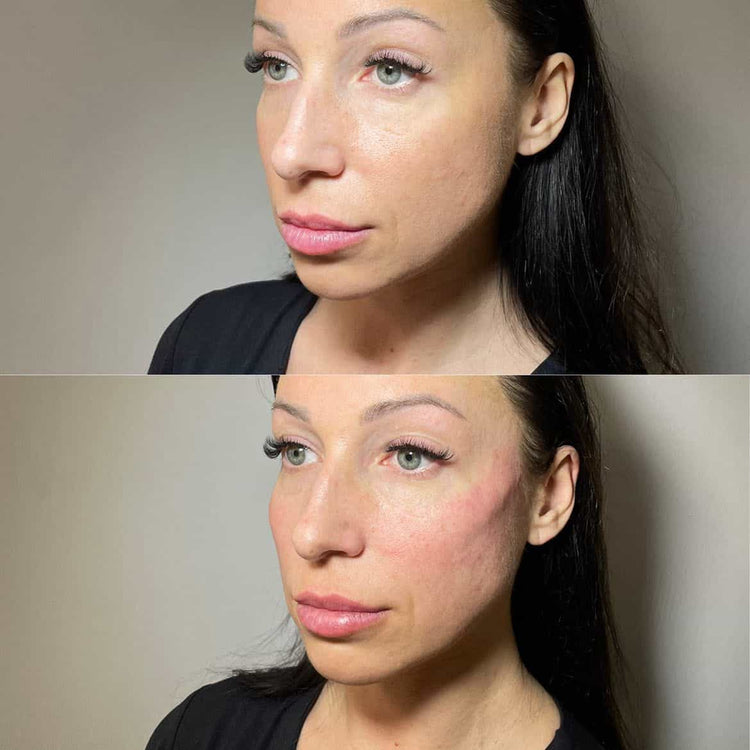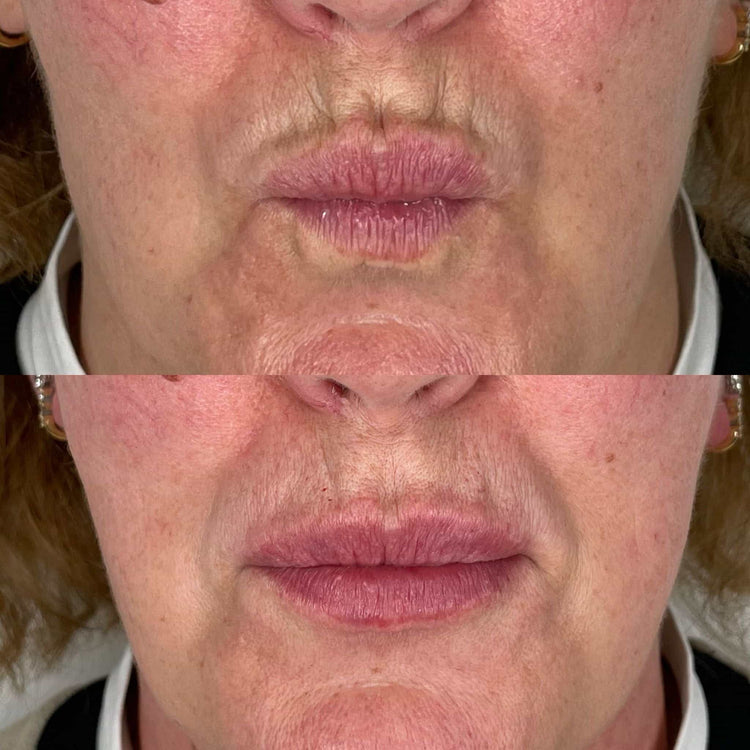Areas Treated with Dermal Fillers
Dermal fillers are non-surgical treatments that enhance facial aesthetics by adding volume and smoothing wrinkles.
Cheeks
One common area treated with dermal fillers are the cheeks. As we age, our cheekbones may lose volume, leading to a more sunken or hollow appearance. Dermal fillers can be strategically injected into the cheek area to restore lost fullness, creating a more youthful and sculpted look.
Jawline Contouring
Another area often treated with dermal fillers is the jawline. The jawline defines the lower part of the face and contributes to overall facial harmony.
With age, the jawline can become less defined due to fat loss and sagging skin. Dermal fillers can be used to augment the jawline, creating a more prominent and sculpted appearance.
Nose Shaping
Dermal fillers offer a range of aesthetic enhancements for various facial areas.
- Cheeks: As we age, cheekbones tend to lose volume, resulting in a more sunken appearance. Dermal fillers can be injected into the cheeks to restore lost fullness and create a more youthful, sculpted look.
- Jawline: The jawline plays a crucial role in defining the lower part of the face and contributing to overall facial harmony. Over time, fat loss and sagging skin can make the jawline less defined. Dermal fillers can augment the jawline, resulting in a more prominent and sculpted appearance.
- Nose Shaping:
Dermal fillers can be used to subtly reshape the nose by adding volume to certain areas, smoothing out imperfections, or enhancing the nasal tip. This non-surgical approach allows for minor adjustments without the risks and recovery time associated with rhinoplasty surgery.
Benefits of Dermal Fillers
Dermal fillers provide a non-invasive way to enhance facial aesthetics by adding volume and smoothing wrinkles. They can be strategically injected into various areas of the face to address signs of aging and achieve a more youthful, balanced appearance.
Reduced Appearance of Fine Lines and Wrinkles
Dermal fillers are injectable substances that smooth wrinkles and restore facial volume lost due to aging.
Fine lines and wrinkles appear when facial muscles contract repeatedly, causing folds in the skin. These lines become more prominent as collagen and elastin production declines with age. Dermal fillers can plump up these areas, smoothing out the appearance of fine lines and wrinkles.
The added volume also helps lift and contour the face, creating a smoother and more youthful complexion.
Improved Facial Volume
Dermal fillers offer a range of aesthetic enhancements for various facial areas.
- Cheeks: As we age, cheekbones tend to lose volume, resulting in a more sunken appearance. Dermal fillers can be injected into the cheeks to restore lost fullness and create a more youthful, sculpted look.
- Jawline: The jawline plays a crucial role in defining the lower part of the face and contributing to overall facial harmony. Over time, fat loss and sagging skin can make the jawline less defined. Dermal fillers can augment the jawline, resulting in a more prominent and sculpted appearance.
- Nose Shaping:
Dermal fillers can be used to subtly reshape the nose by adding volume to certain areas, smoothing out imperfections, or enhancing the nasal tip. This non-surgical approach allows for minor adjustments without the risks and recovery time associated with rhinoplasty surgery.
The benefits of dermal fillers extend beyond simply addressing wrinkles. They can also enhance facial symmetry, balance, and proportions. By strategically injecting fillers, practitioners can create a more harmonious and aesthetically pleasing appearance.
Enhanced Facial Symmetry
Dermal fillers offer a versatile solution for enhancing facial aesthetics by addressing various concerns related to aging and achieving greater symmetry.
As we age, our facial features can become asymmetrical due to factors like muscle development, bone structure changes, and volume loss.

Dermal fillers can effectively counteract these imbalances by adding volume to areas that have lost definition or plumpness.
For example, if one side of the face has a more pronounced smile line than the other, fillers can be strategically placed to even out the appearance and create a more balanced smile.

Similarly, fillers can be used to address asymmetry in the cheekbones or jawline, resulting in a more harmonious and symmetrical facial structure.
Non-Surgical Solution
Dermal fillers provide a non-invasive way to enhance facial aesthetics by adding volume and smoothing wrinkles. They can be strategically injected into various areas of the face to address signs of aging and achieve a more youthful, balanced appearance.
One common area treated with dermal fillers are the cheeks. As we age, our cheekbones may lose volume, leading to a more sunken or hollow appearance. Dermal fillers can be strategically injected into the cheek area to restore lost fullness, creating a more youthful and sculpted look.
Another area often treated with dermal fillers is the jawline. The jawline defines the lower part of the face and contributes to overall facial harmony. With age, the jawline can become less defined due to fat loss and sagging skin. Dermal fillers can be used to augment the jawline, creating a more prominent and sculpted appearance.
Dermal fillers offer a range of aesthetic enhancements for various facial areas.
- Cheeks: As we age, cheekbones tend to lose volume, resulting in a more sunken appearance. Dermal fillers can be injected into the cheeks to restore lost fullness and create a more youthful, sculpted look.
- Jawline: The jawline plays a crucial role in defining the lower part of the face and contributing to overall facial harmony. Over time, fat loss and sagging skin can make the jawline less defined. Dermal fillers can augment the jawline, resulting in a more prominent and sculpted appearance.
- Nose Shaping:
Dermal fillers can be used to subtly reshape the nose by adding volume to certain areas, smoothing out imperfections, or enhancing the nasal tip. This non-surgical approach allows for minor adjustments without the risks and recovery time associated with rhinoplasty surgery.
The benefits of dermal fillers extend beyond simply addressing wrinkles. They can also enhance facial symmetry, balance, and proportions. By strategically injecting fillers, practitioners can create a more harmonious and aesthetically pleasing appearance.
Dermal fillers offer a versatile solution for enhancing facial aesthetics by addressing various concerns related to aging and achieving greater symmetry.
As we age, our facial features can become asymmetrical due to factors like muscle development, bone structure changes, and volume loss.
Dermal fillers can effectively counteract these imbalances by adding volume to areas that have lost definition or plumpness.
For example, if one side of the face has a more pronounced smile line than the other, fillers can be strategically placed to even out the appearance and create a more balanced smile.
Similarly, fillers can be used to address asymmetry in the cheekbones or jawline, resulting in a more harmonious and symmetrical facial structure.
Relatively Quick Procedure
Dermal fillers are non-surgical treatments that enhance facial aesthetics by adding volume and smoothing wrinkles.
- Cheeks: As we age, cheekbones tend to lose volume, resulting in a more sunken appearance. Dermal fillers can be injected into the cheeks to restore lost fullness and create a more youthful, sculpted look.
- Jawline: The jawline plays a crucial role in defining the lower part of the face and contributing to overall facial harmony. Over time, fat loss and sagging skin can make the jawline less defined. Dermal fillers can augment the jawline, resulting in a more prominent and sculpted appearance.
- Nose Shaping:
Dermal fillers can be used to subtly reshape the nose by adding volume to certain areas, smoothing out imperfections, or enhancing the nasal tip. This non-surgical approach allows for minor adjustments without the risks and recovery time associated with rhinoplasty surgery.
These quick procedures involve injecting gel-like substances under the skin to plump up wrinkles and restore facial volume.
Considerations Before Getting Dermal Fillers
Before considering dermal fillers, it’s essential to carefully evaluate your goals, understand the procedure involved, and weigh the potential risks and benefits.
Consultation with a Qualified Practitioner
Before getting dermal fillers, several important considerations should be taken into account.
- Medical History: It is crucial to inform your practitioner about any pre-existing medical conditions, allergies, or medications you are taking. Certain medical conditions may make you a poor candidate for dermal fillers.
- Realistic Expectations: Dermal fillers can enhance facial features but cannot completely reverse the effects of aging. It is important to have realistic expectations about the outcome and understand that multiple treatment sessions may be required to achieve desired results.
- Qualified Practitioner: Consulting with a qualified and experienced practitioner is paramount. Look for a board-certified dermatologist, plastic surgeon, or other licensed medical professional with expertise in dermal fillers.
A consultation with a qualified practitioner is essential before undergoing any cosmetic procedure, including dermal fillers.
- Discussion of Goals: During the consultation, openly discuss your aesthetic goals and expectations with the practitioner. They will assess your facial structure, skin type, and medical history to determine if dermal fillers are suitable for you.
- Procedure Explanation: The practitioner will thoroughly explain the procedure, including the type of fillers used, injection techniques, potential risks and benefits, and expected recovery time.
- Treatment Plan: Based on your individual needs and desired outcome, the practitioner will develop a personalized treatment plan that outlines the number of injections required, frequency of treatments, and anticipated results.
- Questions and Concerns: It is essential to ask any questions you have and address any concerns you may have about the procedure or potential side effects.
Medical History and Allergies
Before getting dermal fillers, it’s essential to consider your medical history and any allergies you may have.
Providing your practitioner with a complete medical history allows them to assess potential risks and determine if dermal fillers are safe for you.
Allergies to certain ingredients in dermal fillers can cause adverse reactions, so it’s crucial to disclose any known allergies to medications or substances.
Realistic Expectations
Before getting dermal fillers, it’s essential to carefully evaluate your goals, understand the procedure involved, and weigh the potential risks and benefits.
First, have realistic expectations about what dermal fillers can achieve. They can enhance facial features, reduce the appearance of wrinkles, and restore volume, but they can’t completely reverse aging.
It’s important to consult with a qualified and experienced practitioner, such as a board-certified dermatologist or plastic surgeon, who can assess your individual needs and advise you on the best course of action.
During your consultation, discuss your aesthetic goals openly and honestly. Your practitioner will evaluate your facial structure, skin type, medical history, and any allergies you may have to determine if dermal fillers are a suitable option for you.

Potential Side Effects
Before considering dermal fillers, it is essential to carefully evaluate your goals, understand the procedure involved, and weigh the potential risks and benefits.
One of the most important considerations is your medical history. Certain medical conditions, such as active skin infections, bleeding disorders, or autoimmune diseases, may make you a poor candidate for dermal fillers.
You should also disclose any allergies to medications or substances, as some fillers contain ingredients that could trigger an allergic reaction.
It’s crucial to have realistic expectations about the results of dermal fillers. While they can effectively reduce wrinkles and restore facial volume, they cannot completely erase the signs of aging.
Dermal fillers are designed to enhance your natural features, not create a drastically different appearance.
Potential side effects of dermal fillers vary from person to person and depend on factors such as the type of filler used, the injection technique, and individual sensitivity.
Common side effects include redness, swelling, bruising, tenderness, and itching at the injection site. These side effects are usually mild and temporary, resolving within a few days to weeks.
Less common but more serious side effects can occur, such as infection, allergic reactions, or vascular occlusion (blockage of blood vessels). It is essential to choose a qualified and experienced practitioner who uses sterile techniques to minimize the risk of complications.
Cost and Maintenance
Before making the decision to get dermal fillers, it’s crucial to weigh several factors. First and foremost, consult with a qualified and experienced practitioner, preferably a board-certified dermatologist or plastic surgeon. They will assess your individual needs, medical history, and desired outcome to determine if dermal fillers are suitable for you.
During your consultation, discuss your expectations realistically. Dermal fillers can enhance facial features and reduce the appearance of wrinkles but cannot completely reverse aging. Be open about your goals and ask questions about the procedure, potential risks, and expected recovery time.
The cost of dermal fillers varies depending on factors like the type of filler used, the amount required, and the practitioner’s experience. It’s essential to discuss pricing transparently with your provider before proceeding with treatment. Maintenance involves repeat treatments to maintain the desired results, as the effects of dermal fillers typically last anywhere from six months to two years.
Enquire about the safety of dermal fillers with Dr. Laura Geige at It’s Me & You Clinic
- What Is The Relationship Escalator And Should You Follow It? - June 2, 2025
- What Helps Lip Filler Swelling - June 1, 2025
- The Evolution Of Graysexuality And Its Influence On Modern Dating Trends - June 1, 2025
